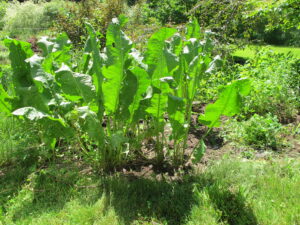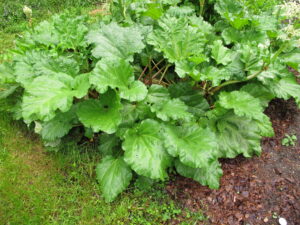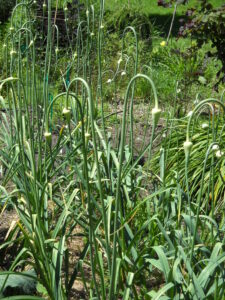There Is a Free Lunch!
Posted on Tuesday, June 28, 2022 · Leave a Comment
My father, may he rest in peace, always told me that there is no such thing as a free lunch. Wrong, Dad. I grow at least three tasty vegetables that require no work to speak of: I just plant, mulch and harvest. If you are a lackadaisical gardener and like garlic, rhubarb and horseradish, you are in luck.

Horseradish is big plant. The roots can be used to make a spicy condiment for sandwiches.
Let’s start with horseradish: It’s in the broccoli family, and once planted, it will never ask anything of you. Yes, it does slowly expand the patch of ground it claims as its own, so you may want to dig some up each year and make horseradish sauce. But if you plant it bordering a lawn on one side and a barn, house or path on the other, it won’t travel far.
The roots of a mature horseradish plant will grow deep, probably all the way to China. So when you dig it, some will always be left in the ground to come back. I have extracted roots longer than 18 inches. The plant is tall, easily three or four feet, and the leaves are wide and a bit coarse looking. Not a particularly pretty plant. And although it produces little white flowers, it doesn’t produce viable seed. You can start it from a scrap of root you get from a friend at harvest time.
The sauce can be very powerful or more mild – depending on how you make it. Wash the roots with a scrub brush, then peel with a potato peeler. Chop into chunks under an inch in size, and put in a food processor or blender. A cup of chunks will make all I need for a year. I blend the chunks with half a cup of water or so. It takes a few minutes of blending to get it to the right consistency as this stuff is fibrous and tough to break down. Don’t overheat your blender, so stop and start.
If you want mild horseradish add a third of a cup of vinegar pretty much right away. If you want it hot (which I do), wait a few minutes after blending, then add it. The mix should be spreadable with butter knife and juicy. Store it in a glass jar, preferably with a plastic lid. Metal lids rust and dissolve from the fumes in less than a year.
The fumes when blending are powerful, so don’t get your eyes and nose by looking into the blender. You may even want to do the job outside on the deck.

Rhubarb does best in rich, moist soil but will grow most anywhere
Rhubarb is a wonderful vegetable, even if old-fashioned. Like horseradish, it is a forever plant that once planted should provide you with treats for the rest of your life. You can buy a plant or get a friend to divide and share some roots. Some rhubarb has red stems, others green stems. They taste the same, but I like the red color. The leaves contain oxalic acid and are not edible.
Since rhubarb is going to live forever, I recommend adding lots of compost and some slow-release organic fertilizer at planting time. If dividing rhubarb, early spring is the best time to do it, but anytime it all right. It grows best in full sun, but as a leafy green it will thrive in part sun, too.
I like making rhubarb punch as an early-summer refreshing drink. Pick a few stems, and cut into one-inch chunks. Add an equal amount of water, and boil until the rhubarb is falling apart. Sieve through a colander or sieve. The add water – a cup of fruit will easily make a quart of punch, or even two, depending how you like it. Add sugar to taste and serve cold.
Garlic should be planted in October, and it is ready to harvest in July. This year mine started to blossom in late June, sending up curly stalks called scapes that are edible and decorative. I will resist picking any bulbs of garlic until mid-July or later so it can reach maximum size. But don’t wait too long: if you do, the outer layers of leafy material that cover each bulb will start to break down, and it will not store as well.

Garlic that is near ready to pull.
Okay, I looked at mine today and did see a few weeds I should pull. But it really is essentially a work-free crop. I plant cloves three inches apart and three inches deep in rich, compost-containing soil. Full sun is best. Once planted, I mulch it heavily – up to a foot of fluffy mulch hay or straw. Over the winter it will pack down to just three or four inches. In the spring the leaves will grow right through the straw, but weeds do not.
Garlic stores well in a cool, dry place. By now, some of last year’s garlic is starting to sprout in the kitchen. I have made garlic powder by drying it in a food dehydrator, then grinding in a coffee or spice grinder, but normally I just store it. I have read that one can freeze it, too, but haven’t done so yet. Don’t store it at room temperature in oil – as a root crop there is always the possibility of getting botulism.
Whatever you plant in the garden will reward you well beyond the work it involves to grow. To get good results do these things: prepare the soil well, and add compost. Provide plenty of sunshine – even if it means planting in the front lawn. Water regularly in hot times, especially early in the season. Pick you veggies when they are small and tender, that’s when they will taste best. And lastly, don’t let the weeds get ahead of you. Never let weeds blossom and distribute their seeds. Mulch is an easy way to keep weeds at bay, particularly if you put down a few sheets of newspaper under the straw or hay.
Henry is a lifetime organic gardener who stores and eats something from his garden every day of the year. He lives in Cornish Flat, NH and is the author of four gardening books.





